
|   |

|   |
 e-mail: sunilkothari1933@gmail.com First edition of Kalahrnisham National Dance Festival Photos courtesy: AMK Fotography March 12, 2019 For readers who do not know Dombivli, a suburb of Mumbai, it is next station to Thane on way to Kalyan. The well known young Bharatanatyam dancer and teacher Pavitra Krishna Bhat, originally from Mangalore, moved with his parents some thirty years ago to Dombivli. As a child he had great passion for dance. His parents indulged him. He only studied elementary Bharatanatyam from his first teacher but that did not deter him from performing anywhere. His parents also pushed him to perform during occasions like Satyanarayana puja or Ganeshotsava. With complete involvement Pavitra performed and made onlookers happy with his endearing personality and dancing. Later on his father put him to study under Deepak Majumdar, a disciple of Kadirvelu, a traditional Bharatanatyam nattuvanar. Deepak found in him a diligent student wanting to put in practice even for eight hours a day! Pavitra says that his devotion to his parents is very deep. When his mother was not keeping good health, in-between taking classes he would find time to go home and look after his mother. When his father retired and took over, Pavitra got more time to devote to dance. Soon he began to draw attention of more discerning audiences. He performed at annual celebrations of various institutions and schools. His passion and his natural gifts brought him within mainstream of dance in Mumbai. Some six years ago, I first saw him performing during a show at Ravindra Natya Mandir Mini Auditorium. I was impressed. I watched him in a school performance in Chennai soon after and later on in group choreographic works of renowned Bharatanatyam teacher Anitha Guha. One performance led to another and I saw him in the morning slot of Classical Dance Festival of The Music Academy of Madras. His solo of Rangasayee was most impressive. One more performance at Dhauli-Kalinga festival sealed the impression of a bright Bharatanatyam dancer. As happens in case of several male Bharatanatyam dancers, to promote his career, he also took part in group choreographic works of Anitha Guha and independent works of young Bharatanatyam dancer Rukmini Vijayakumar. He travelled with her abroad. The other male dancer in the troupe was Parshwanath Upadhye, who has been already making a name as a brilliant Bharatanatyam male dancer. During his growing up in Dombivli, Pavitra established his Pavitra Arts Visual Institute (PAVI) and started teaching Bharatanatyam to children from age of 7 to 10. Since there were not many institutions in Dombivli offering training in classical dance forms, the local resident parents flocked to his institution to register their children for dance lessons. There was no looking back for young Pavitra, as there was such an unprecedented demand for classical dances. Soon the number started growing and reached to 500! Pavitra devised batches, engaged other teachers who could teach at different hours the large numbers of students in various sizeable groups. Soon Dombivli began to draw attention of organizers to present children in annual shows. Pavitra recalling his own performances at age of five encouraged his 'tiny tots' to perform at various religious functions, thereby exposing them to larger audiences. When Pavitra invited me to Mumbai for his new venture titled Kalahrnisham (Feb 22 & 23), meaning art day and night, which was given by his Bharatanatyam exponent wife Aparna Shastry, I was delighted to accept. It featured senior dancers Uma Dogra (Kathak), Aruna Mohanty (Odissi) and Sandhya Purecha (Bharatanatyam) on the first day and on second day the lineup was of Rahul Acharya (Odissi), Gauri Diwakar (Kathak), Ragini Chandrashekar (Bharatanatyam), and three young dancers Abha Mohan (Mohiniattam), Aparna Shastry (Bharatanatyam) and Amrita Lahiri (Kuchipudi). Kalahrnisham was organized by INKLING under the guidance of Pavitra Art Visual Institute (P.A.V.I). INKLING is a new born event management company, founded by Mamta Bajoria, with a vision to organise events that encourage the rich Indian culture and showcase the talent lying within India. The main reason was that the younger generation of dancers who have been individually seen, occasionally, in Mumbai, have never been seen on one platform in one evening. To expose Mumbaikars to this talented generation, who will ultimately take over from the senior dancers, it was necessary to have 'a festival with a difference.' 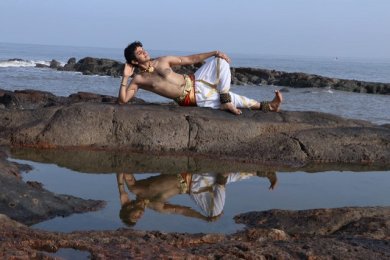 Pavitra Bhat 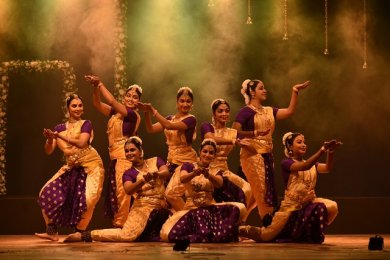 Senior disciples of Pavitra Bhat On the first day, one of the chief guests was senior most traditional Guru T.K. Kalyanasundaram of Rajarajeswari Bharatha Natya Kala Mandir, which is 74 years old. His presence was most cherished by the dancers. Held at Rabindra Natya Mandir next to Siddhi Vinayaka Temple, an important landmark, its vast stage offered dancers scope to explore the space. PAVI's senior dancers performed Pushpanjali as an invocation number. Their perfect synchronization and flawless presentation was impressive and indicative of what Pavitra aims at imparting to students at his institute. The group of eight included Aswathi Panicker, Ashwati, Shweta Menon, Purva Bapat, Sneha Nadoran, Anjana Menon, Nikita Amin and Hridaya Sharad. Kathak exponent Uma Dogra, disciple of Pandit Durgalal, with her accompanists Pandit Kalinath Mishra of Banaras Gharana on tabla, vocalist Manoj Desai, sarangi player Sandip Desai, and a sitar player Alka Gujar, opened her recital with Tukaram's abhang in Marathi "Sundar te dhyana, ubhe vite vari" regaled the audience with devotional song, at once establishing rapport with the audience familiar with this popular number. She invested it with Kathak vocabulary, using elements of thaat, tatkar, gat bhav, and chakkars ending with a climax of 'Vithal, Vithal, Vithal' and what they say in Kathak parlance, 'sama bandh liya' set the mood. With her natural flair and open ended exposition of Jaipur Gharana, along with her two senior dancers performing to Dhamar tala of 14 beats, she wove intricate patterns with tode, tukde, aamad, paran, footwork, chakkars, doing padhanta, reciting mnemonic syllables displaying her technical virtuosity. What engaged audience's attention was her abhinaya to Gita Govinda ashtapadi "Sakhi he keshi mathanamudaram" to the melodious singing by Manoj Desai. This is a recent trend revived of performing ashtapadis in Kathak. Earlier, late Maya Rao had enacted abhinaya to ashtapadis in early seventies. Uma Dogra has been attempting abhinaya to ashtapadi with restraint bringing subtle nuances registering bhavas of shyness, Krishna and Radha's first encounter as told by Radha to sakhi, how with sweet nothings he embraced her and kissed her, how he was waiting for her behind a bower, when she as abhisarika nayika, emboldened in a dark night, overcoming difficult path, serpent, went to see him and how charmingly Krishna came from behind and placed his palms on her eyes! Shringara rasa was evoked with mukhajabhinaya and angikabhinaya with simple but communicative expressions, and economical hand gestures. 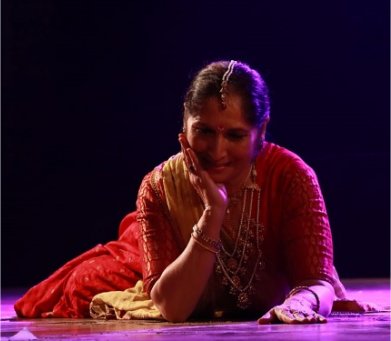 Uma Dogra 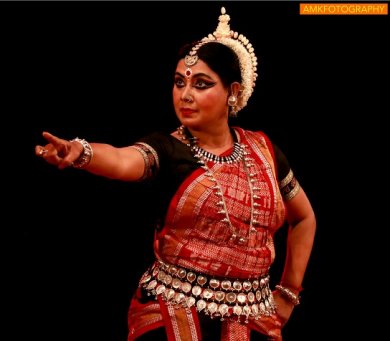 Aruna Mohanty From Bhubaneswar, Odissi exponent Aruna Mohanty selected two of her favourite works 'Sansara' and 'Nayaka and Pratinayaka'. A versatile dancer, Aruna excels in choreographing themes 'out of the box'; telling the story of human being from birth to death, various stages of life, the final journey within traditional format were depicted in a seamless manner. The final truth that dawns on mankind is resort to God; Bhaja Govindam was sung and danced with abundance. Each time Aruna performs it, her characterization of various nayaka and pratinayaka get sharper. 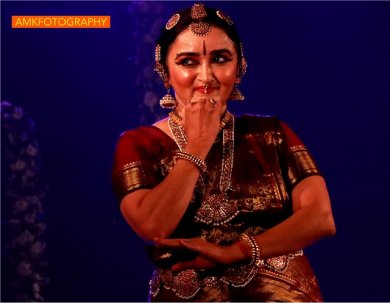 Sandhya Purecha Trained by Acharya Parvati Kumar, Sandhya Purecha selected Maratha King Sarabhendra's composition known as Nirupanas. The first one was telling her sakhi, "How can you call Lord Shiva 'bhola' - innocent? He is Nilakantha, having drunk poison that stopped at his neck, playing game of dice and when he lost removed his clothes and turned Digambara, also blessed me making his ardhangi, in form of ardhanarishwara, no way I am going to believe he is bhola." The second composition was an example of 'Bhranti alankara', in which Parvati requests Kamadeva, who was burnt to ashes when he attacked Lord Shiva with flowery arrows, and Shiva opened his third eye. She begs of him not to mistake her for Lord Shiva. The plait of her hair is not jata of the lord, the kasturi applied to her neck is not representing blue neck of the lord, the dried up flower on her hair is not crescent moon, and if her body has turned colourless it is not ashes of the lord, but her body has gone pale from pain of separation. 'O Kamadeva, do not mistake me and take revenge upon me.' Similar pada is found in Vidyapati's song "Kahe dahata Madana tanu hamara?" Why do you burn me, O Madana? Guru Bipin Singh has choreographed it both in Sanskrit and Mithila bhasha for the Jhaveri Sisters. It was interesting to see how the two poets of different regions have created similar poetry. Since Pavitra had invited her to perform closer to the 99th anniversary of her guru, Sandhya considered it a golden opportunity to pay tribute and performed "Aaj Sonyacha Diwas," - today is a golden day for me - and depicted that for a devotee to have glimpses of the divine couple Lord Shiva and Parvati was such a blessing. The devotional mood permeated in all her presentations. On second day, the lineup of the younger dancers created quite a buzz and the Mini Hall of Ravindra Natya Mandir was occupied well in advance. The intimate auditorium offers spectators to watch dance and in particular, abhinaya from near. Like previous day in order to showcase his 'tiny tots' ranging from age of 7 to 10, Pavitra presented Amulya, Aditri, Disha, Ragini, Trisha, Mrunali and Swara in a group choreography of dance of Shiva, being witnessed by his two sons Ganesha with his vahana mushika and Kartikeya with his vahana Mayura. The musical accompaniment on mridangam and various instruments was enacted in quick succession, two dancers on one side and the other group dancing on other side. The concept of group choreography and making them dance from very young age was laudable. Pavitra wanted them to follow his own footsteps when he was young and performed at various events. He said that this group of dancers regularly performs on various occasions. 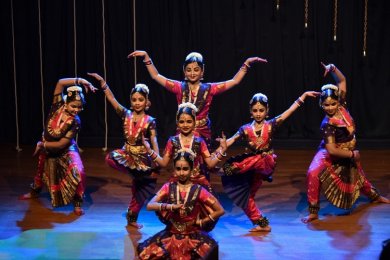 Pavitra Bhat's junior disciples 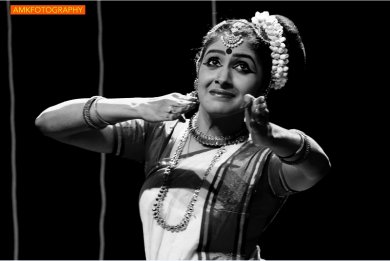 Abha Mohan From Cochin, celebrated Mohiniattam dancer Neena Prasad's disciple Abha Mohan presented traditional Cholkattu, a number of pure dance, ending it with a shloka from Taittiryopanishad extolling the supremacy of Guru. Performed in raga Hamsadhwani and khandajathi triputa tala, Abha displayed typical graceful movements of Mohiniattam. The second abhinaya number was Mohini, which incorporated the story of Vishnu taking Mohini form and distributing nectar to the Devas after churning of the ocean. The refrain Kandarpa Veejitha Mohini found felicitous expression and allure of Abha's dance. The original choreography of this number was by Kalamandalam Sugandhi, set to Suddha Dhanyasi raga and mishrachapu tala. Abha concluded her recital performing Mahanadi, poet Vallathol's kriti describing the divine beauty of Krishna. It was further complemented with Narayana Tirtha's 'Madhava Mamava Deva,' in Nilambari raga and adi tala, in which Yashoda attempts to cajole child Krishna to sleep. The various pranks of Krishna, and Yashoda's indulging him were expressed in appropriate motherly love. This was Abha's first appearance in Mumbai. She created a favourable impression as a competent young dancer. Ragini Chandrashekar, daughter and disciple of Jamuna Krishnan from Delhi is a seasoned dancer performing from a very young age for past 30 years. Hers is a strong and sound Bharatanatyam training under various gurus like K.N Dakshinamurty, Karaikudi Shivakumar and Kalanidhi Narayanan. There is a punch and gravitas in her technique and an effortless execution. She selected Annamacharya's composition with 'Sriman Narayana' refrain, extolling the divine god residing on the top of the seven hills. Worshipping his feet, she recalls how his feet in Vamanavatara, gave moksha to Bali Raja placing foot on his head, performed on hood of Kaliya, brought alive image of Vishnu as Garuda gamana, astride his vahana Garuda, Mukhakamala, face as beautiful as lotus, and as Padmanabha, with Brahma sitting on lotus which rises from his navel. In Gita Govinda ashtapadi "Sakhi he keshi Mathanamudaram" as she has studied from Kalanidhi Narayanan, Ragini displayed mukhajabhinaya, using her eyes eloquently creating characters of Radha, looking at Krishna, Krishna admiring her and in a trice moving her eyes as Radha telling the story to her confidante. The expressions moved fleetingly on her mobile visage. With years of experience, under supervision of her mother, Ragini has acquired maturity in her abhinaya. Ragini was in her element dancing Suradas's pada telling how Krishna danced on hood of Kaliya, "Nachata Nanda ala, pala," using several jathis to suggest variegated patterns. And in later section how Kaliya felt blessed by the touch of Krishna's feet and achieving moksha. To the singing of "Aisi kripa kari," how he blessed Gajendra and his devotees, Ragini suggestively as well as dramatically evoked those images of Krishna's deeds which Surdas sings with joy. Indeed, Ragini's dance was full of joy. 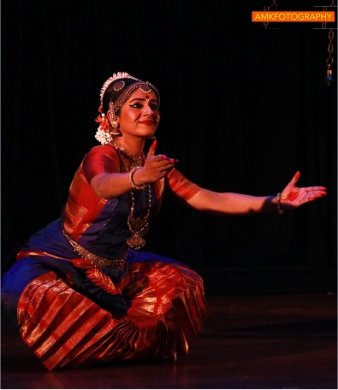 Ragini Chandrashekar 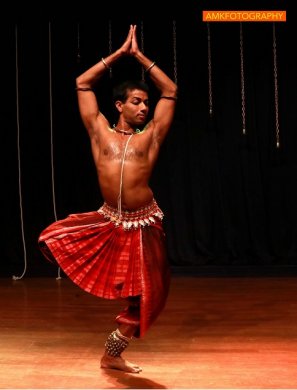 Rahul Acharya From Bhubaneswar, Odissi exponent Rahul Acharya, disciple of Durgacharan Ranbir, presented Suryashtakam, choreographed by his guru known for arresting choreography in Odissi. Rahul introduced yoga movements before the shlokas started, displaying his command over his agile body, which could take several bhangas, body bends including atibhanga, in which bending backward his head, the raised foot touches the head. His imaginative approach using Surya Namaskar was praiseworthy. The rest was entirely as per his guru's creation. The prayer to 'Adityaya namaha, Divakaraya namaha,' the image of a chariot driven by seven horses et al was danced in a superb manner. Rahul's virile body offering 'Tam Suryam pranamyamaham' left an indelible impression. He has been growing from performance to performance. Set to raga Bairagi and tala jati composed by Pt Ramahari Das and rhythm by Niranjan Patra, the script was analyzed by Pt Nityananda Mishra. It was sheer pleasure to watch a young dancer bringing out the beauty of Odissi dance in purushochita, appropriate manly manner. Originally from Andhra but settled in Bangalore, and now in Mumbai after her marriage with Pavitra Bhat, Aparna Shastry Bhat, is a disciple of Radha Sridhar, a senior disciple of Kittappa Pillai. Tall, with lithe body, Aparna has a commanding stage presence. In the popular "Aade namma" composition, set to Paras raga and adi tala, the iconic image of Lord Shiva's dancing, Ganga flowing from his matted locks, his own dancing in 'Kunchita' pada, the beauty of its dance incorporating Panini's sutra, in left hand the drum, in one hand agnipatram, fire, in ears kundalam, entire body besmeared with ash, the description was graphic. In his ardhanarishwara form, the devotees pray reciting 'Om Namah Shivaya'. The symbolic meaning of Ganga as the flow of knowledge is subtly conveyed. Aparna studied Kshetrayya's padam "Nanne pelladu sumee" from Bragha Bessel in Ragamalika and adi tala. She projected mugdha, madhyama and proudha nayika. Beseeching Krishna as a young mugdha nayika, she tells him while playing not to break castles she makes in sand. She begs of him to be discreet, not to hold her hand when all are watching, not to embrace her. Aparna, with feminine nuances becomes a nayika in love with Muvva Gopala, saying that he was bound to marry her with all the promises he had given her. Aparna registered the bhavas in a manner which were full of auchitya, appropriate without being overdone. But she was in her element while dancing Oothukadu Venkatasubbaiyer's Kalinga Nartanam. It is one of the finest compositions offering scope to a dancer to dance to various onomatopoetic jathis, mnemonic syllables and like in Kathak there are kavits, which are recited; in this composition also the text is recited in various tempos, highlighting the nritta aspect. Nandakishora, Navanitachora, Jamuna Taranga, jala jala, Nilamanohara, Bhujanga Nartana, describing it dancing lying close to the floor, and so on, the dance gathers pace, with vividha nartana, murali nada which enchants three worlds. Aparna enchanted the audience with her performance.  Aparna Shastry 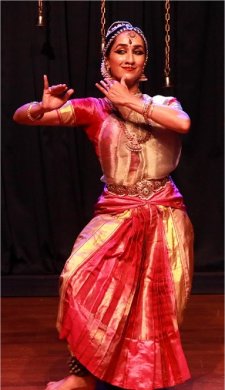 Amrita Lahiri 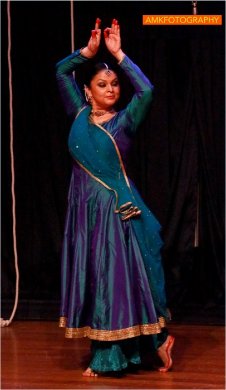 Gauri Diwakar Currently studying under Vempati Chinna Satyam's senior disciple Mosalikanti, Amrita Lahiri has displayed her imbibing Vempati bani, enhancing its technical brilliance. Known for seeking innovative themes, she with assistance of Odissi exponent Sharmila Biswas took the theme of Murchhana and developed it further with her own choreography retaining Kuchipudi format and its lilt. She presented excerpt from her larger work Murchhana for which Sudha Raghuraman has set the music. Referring to dance of celestial dancer Rambha, seven notes of music, the confluence of Geet, Sangeet and Nritya in Kuchipudi, the theme of Murchhana is taken from oral tradition of khol players of rural Odisha. These stories have roots in ancient texts, but have evolved into many branches, having been told over generations. Brahma creates mridanga, plays and creates sounds, listens to solfa swaras, flying across the sky Murchhana with story of Mohini form, which Vishnu took to distribute nectar to Devas, moves on. Amrita uses the ploy of storytelling, sitting on stage and turning pages of the book. When Krishna played the flute, the gopis left all chores incomplete and ran unto him to join in rasalila. But one gopi Tungavidya was not allowed by her husband, who tied her to a pillar when she tried to run away to join Krishna. She could not bear to remain away from Krishna and hit her head on the pillar to which she was tied and died. Krishna took her body away and transformed into mridanga and the sound of mridanga became one with the sound of various instruments, flute and Murchhana thus became one with all who were dancing with Krishna. The joyous dancing with refrain of 'Rase Raseshwara' concluded the story of Murchhana. In this version Amrita was in her element, scoring over her previous performance, which I happened to see. It was tighter and full of exquisite Kuchipudi movements with soul stirring singing of Sudha Raghuraman. The finale came with Kathak exponent Gauri Diwakar. Disciple of Pandit Birju Maharaj, his son Jaikishan Maharaj and later on perfecting her skills under Aditi Mangaldas, Gauri has carved her own niche as a distinguished dancer and a choreographer. She with her own choreography of Suradas pada, after the rendering of Ashwini Bhide's 'Sukha sadana Shyam ko,' 'Sundar vadan' the beautiful face of Lord Krishna elaborated with pure dance investing the intra forms of Kathak like tode, tukde, paran, chakkars, tatkar, footwork which in Kathak style invariably wins rounds of applause. Well designed costume with layers of flaring skirts, enhanced the visual appeal of chakkars. With stanza "lakhan ki chaturai, uthai Genda gaganvidha," across the sky, the ball fell in Yamuna river, where resided Kaliya serpent, poisoning the water, and to retrieve the ball Krishna jumped into the river and engaged in battle with Kaliya, subjugating him. There were references about Krishna who stole hearts of gopis, 'chitavan', and as a charioteer of Arjuna, to that Krishna, Suradas bows. Gauri was completely immersed in performing the episodes with minimalism. The other well known poem of Suryakant Tripathi, 'Nirala' choreographed by Aditi Mangaldas, 'Nayano ki dor,' the outline of the eyes, dwelt upon meeting of Krishna's and Radha's eyes, the night spent in joy, the light of lamp blown off, the morning replete with joy, et al found expression along with Kathak vocabulary. Rendered by Samiulla Khan, I suggest it needs clear enunciation. Gauri's nritta was sparkling, full of energy and bravura. Polished, sophisticated movements looking perfectly aesthetic added charm to Gauri's performance. Here is a dancer who is equally at ease with group choreography, working with other choreographers, adding novel concepts to her renderings. She received hearty applause for her lightning chakkars with which the evening came to a close. The festival was a runaway success.  Dr. Sunil Kothari is a dance historian, scholar, author and critic, Padma Shri awardee and fellow, Sangeet Natak Akademi. Dance Critics' Association, New York, has honoured him with Lifetime Achievement award. Post your comments Please provide your name and email id when you use the Anonymous profile in the blog to post a comment. All appropriate comments posted with name & email id in the blog will also be featured in the site. |